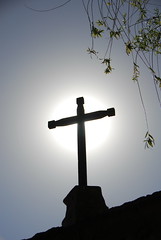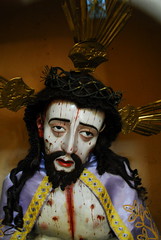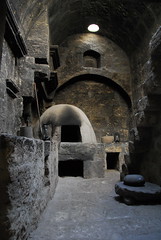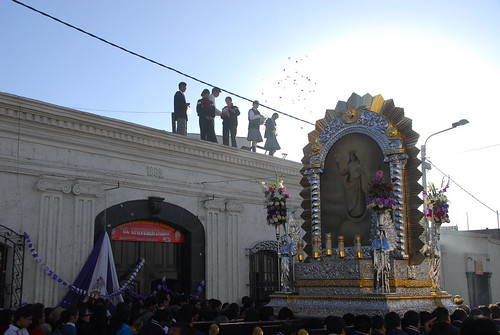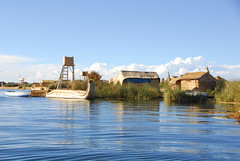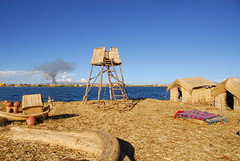From Chile to Peru… Arequipa and Lake Titicaca
While we were in San Pedro de Atacama, we decided that we had enough of being inland and wanted to boot it on up to the coast. A big part of our motivation for this trip had been to improve our surfing somewhere nice and warm and we were both itching to get diving again. So we decided to skip Bolivia, leg it up to Cusco in Peru, see Machu Picchu and then fly on up to the beaches of North Peru, continuing slowly up to Ecuador. We had relaxed plenty in Chile and Argentina so we felt well-rested and in the mood for a bit of speed travelling again. Funny what happens to the best made plans… just when we decided to speed things up, fate intervened.
First we had the five days waiting in San Pedro for the star man, then a few nightmare bus journeys and delays in Peru, but more about that later on.
After leaving San Pedro we got an overnight bus to Arica, which is a fairly uneventful border city in northern Chile. There´s not much to do there but we spent a day anyway, staying in a very strange hostel called ´Sunny Days´, where breakfast was accompanied by the sounds and sight of an old woman groaning and moaning in a bedroom off the common area (we later heard she died the day after we left and the hostel was taken over by grieving family and friends… mmm nice holiday vibe).
To cross the border to Peru from Arica there are three choices, a slow (but apparently very nice) train ride, a local bus that takes forever, or a ´collectivo´- a taxi ride taken with five others, where the driver sorts out everything for you after you hand over your passport and a couple of pesos. Yes, handover your passport… sounds very dodgy I know, but after consulting a few people who´d done it before, we were convinced it would be okay and so we hooked up with some other travellers and got quickly on our way. The collectivos are all old American cars; chevys and oldsmobiles with double front seats so that they can carry five passengers plus the driver. The border crossing went grand and we arrived in Tacna less than two hours later. From Tacna, we got on the first bus to Arequipa, which was where our bus trouble started.
The journey was mainly all through desert and it felt like we in the middle of nowhere when the bus first came to a grinding halt on the side of the road. We had chosen the worse seats on the bus to begin with, upstairs right at the front, a nice little sauna-like heat trap with no airconditioning and no view of the telly, just sand. So when the bus broke down, we were already pretty fed up (accustomed as we were to travelling in luxury in Chile & Argentina), but we only really started to worry when the locals began to gather their bags and starting hitching. Luckily it wasn´t a major breakdown and after an hour of messing with the fan belt we were off again, only stopping every twenty minutes or so to blow off some steam (it sounding like air being released from the brakes). We finally arrived in Arequipa safe and sound just a few hours later than expected.
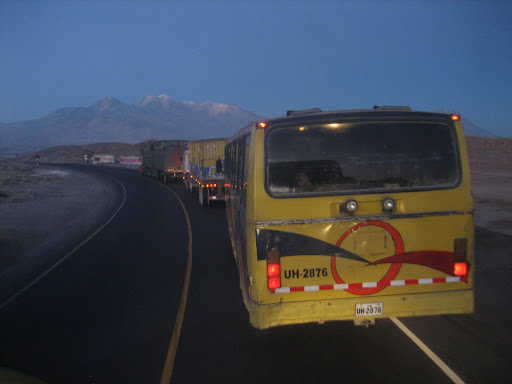
Arequipa is a very pretty city with a really beautiful plaza, but we only stayed a day as we were determined to move on to Cusco quickly and one day was enough time to see some of the main sights; the mummy Juanita and the Santa Catalina convent. Juanita was an Incan child-sacrifice who was killed and buried on the top of a local mountain as a sacrifice to the gods about five hundred years ago. Because she was encased in ice, she was very well preserved when she was found in 1995 by archaeologists. As when we went to see the Bog People in the National Museum in Dublin last year, I found the whole thing very interesting but a bit weird; exactly when is it okay to dig up dead people and put them in a glass box for everyone to look at?! Five hundred years is not a long time really. But apparently, other child sacrifices have been dug up in recent years by grave-robbers and sold to private collectors, so archaeologists say it is better to remove them so they can contribute to our understanding instead of ending up in someone´s living room.
The Santa Catalina Monastery is a five acre city within a city where a few nuns still live, but which used to be populated by hundreds of hedonistic nuns before the pope sent in a strict mother superior to sort them out. It takes a few hours to get around but is worth a visit (especially if you´re interested in architecture), although we were both a bit bored by the time we´d seen it all.
By the end of our day strolling around the town and the convent, we were all holied out as we got caught up in some sort of religious procession on the way back to our hostel.
After our day in Arequipa, we were due to travel to Cusco on a night bus but on arrival at the station we were told the bus wasn´t running due to road blocks put in place by strikers outside Cusco. We were advised that our best bet was to head for Puno on the banks of Lake Titicaca the next day and try to connect to Cusco from there. So we did that, only to arrive in Puno the following afternoon to be told that the buses were not running from there either. Since we were already at Lake Titicaca, we decided to do a short trip out to some of the islands to see what all the fuss is about.
Lake Titicaca is on a lot of itineraries for South America. It´s a very large lake at a high altitude where the attraction is to observe the islands themselves as well as the customs and lifestyles of the indigenous people who have lived there ‘as they have done for hundreds of years’. The lake is on the border between Peru and Bolivia so it can be visited from either side. We stayed on the Peruvian side but perhaps the Bolivian side is better, as Puno really is nothing to write home about; the view of the lake was not very impressive; it just looks like any old lake! As it was 3pm when we got there, the only tours going were to the Islas Flotantes, the floating reed islands. I had read in the Lonely Liar (Planet) that some people found the islands disappointing as they are so commercalised, so I had low expectations, but I can now echo that view and add to it.
We visited three islands, all tiny structures made entirely from reeds that you could walk around in about a minute. There is a short-lived novelty factor when you step off the boat and feel the ground sink a little underneath you (it reminded me of jumping between mud islands in the slurry pit in my grandad´s farm when I was young). The first island consisted of about six little reed huts, a few women selling trinkets and jewellery and about four little kids who followed us around saying “money, money”. Ourselves and the other tourists looked at them and their houses, took photos and got back on the boat. The whole thing felt a bit like a human safari and in a way I wasn´t sure what to make of it, but my overwhelming gut feeling was that the islanders are just waiting for the tourists to arrive and so life is not as it ‘always has been’ for them; in particular, twenty years ago their kids would not have learned to beg like that.
My experiences in Tanzania taught me how dangerous it is for people in developing countries to become in any way reliant on westerners, especially kids; it can erode their self-respect and lead to a sense of inferiority which is a determental thing for any community. I´m all for charity where it is needed, but these kids were not starving streetkids in a big city that we had just stumbled across: we had come on a boat to their home to ´observe´ them and their tiny environment and to me there´s a world of difference. We met lots of others who had great experiences on the other islands on the lake, which is good for them; maybe we should have stayed and gone to the bigger islands, but this one trip put me right off and left me with the negative feeling that I had participated in the worst type of tourism. Besides all this, neither of us felt that the lake or the floating islands were worth the detour, so we went back to the bus station early the next morning hoping the strike would be over and we´d have an easy seven hour journey on to Cusco… how wrong we were.
Tags: Arequipa, Arica, Islas Flotantes, Juanita, Lake Titicaca, Peru, Puno, Santa Catalina Monastery, Sunny Days, Tacna

